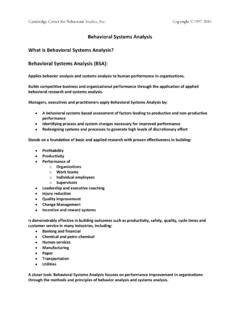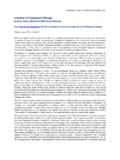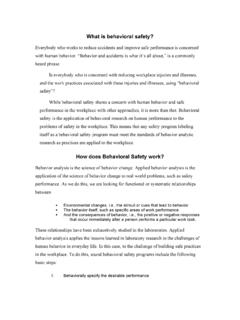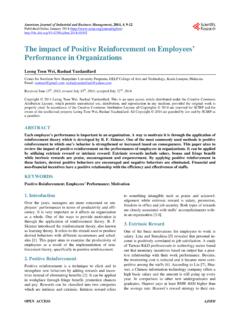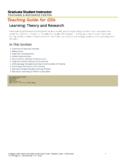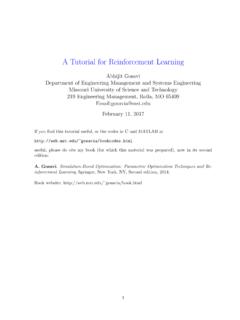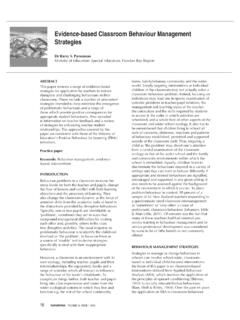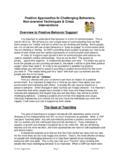Transcription of Behavioral Contingency Analysis
1 Behavioral Contingency AnalysisA formal symbolic language for the Analysis of Behavioral contingenciesFrancis MechnerThis presentation explains the main features of a symbolic language for codifying and analyzing Behavioral contingencies and provides some examples of its applications. Contents and OrganizationIntroductionElements of the Behavioral Contingency languageThe recursive syntactic structureEffects of the analyst s focusThe grammar of consequencesPrevention contingenciesDeception and entrapment And and or relationshipsCodifying probabilities and uncertaintiesRecycling contingencies and changing consequencesDeception in economics and financeCategorization of Behavioral contingenciesSlides 4- 29 Slides 30- 87 Slides 88-101 Slides 102-107 Slides 108-116 Slides 117-129 Slides 130-160 Slides 161-176 Slides 177-187 Slides 188-211 Slides 212-245 Slides 246-252 INTRODUCTIONWhat are Behavioral contingencies?
2 Behavioral contingencies state the if-thenconditions that set the occasion for the potentialoccurrence of certain behavior and its example:ifa certain party performs certain behavior,thencertain consequences may the desired meaning of if is if and only if and the desired meaning of then, is then and not otherwise. If, ifpart of the statement is key, as a Behavioral Contingency can exist and be in effect without any of the specified behavior or any of its consequences ever of Behavioral contingencies If you drop the glass on the floor, it may break. If I pay for the product, I can take it home. If Joe extends his hand to her, Jill may shake can be in effect without anyone ever doing anything and without anything ever are normally not aware of the operative Behavioral contingenciesEvery living organism is continuously subject to thousands of Behavioral contingencies are always present and operative, affecting our every operant act and movement, without our ever being aware of them, just as we are unaware of gravity or the air we breathe.
3 Names of Behavioral contingenciesMany terms in our language refer to acts that create Behavioral that imply positive consequences:propose, invite, suggest, offer, encourage, tempt, that imply negative consequences:warn, threaten, deter, mislead, deceive, blackmail,demand, entrap, seduce, entice, con, defraud, conceal, camouflage, disguise, tempt, etc. Nouns corresponding to these verbs (advice, proposal, threat, invitation, warning, etc.), refer to the contingencies that are contingencies are involved in everyday interactions Statements of the general type If you do A, I will do B, state Behavioral contingenciesExamples: promises, enticements, requestsinducements, demands, offers, elaborate, conditional, or qualified statements may refer to other parties, time periods, probabilities, and contingencies are at the root of the Behavioral phenomena in: Education and child management Economics Business and management Law Government and public affairs The rules of gamesIn Behavioral technologyBehavioral contingencies are the main tool in applications of behavior Analysis including: clinical interventions behavior modification educational technology organizational managementApplications in educationEducational systems involve the Behavioral contingencies for the interactions of.
4 Teachers students parents administrators unions publishers members of the community. Applications in organizational managementManagers operate on Behavioral contingencies when they seek to improve: incentive compensation systems work flow systems safety practices communication systems quality control systemsIn Behavioral and Neurobiology Research: A formal language for codifying Behavioral contingencies helps specify independent variables precisely and can also help identify confoundingvariables that may otherwise beoverlooked, as well as non-obvious parameters of independent variables. Applications in lawLaws, as well as contracts, agreements, and treaties, consist, in general, of if, then statements of the form: If a party does or doesn t perform certain acts, certain consequencesfor that party shall follow. The consequence can be behaviorIn Contingency statements, the consequence of the possible act can also be some behavior:If Joe plays his drums at night, the neighbors might complain.
5 If you feed the dog at the table during our meals, he will often come begging during our you park illegally, the cop may give you a statement need not be true to be a valid Behavioral Contingency statement: If you park illegally, you will always be towed away, though not true, is a valid Behavioral Contingency between Behavioral contingencies and behaviorIt is important to distinguish between two types of consequences:(a) consequences caused by a possibleact withina Contingency , and (b) consequences, including Behavioral effects, caused by the presenceof the Contingency . Distinguishing between acts and contingencies as causes of Behavioral eventsIn a typical Behavioral Contingency statement, the consequence of an act, if it occurs, can be another Behavioral presence of the Contingency as a whole can be the cause of a different Behavioral :Consider the Contingency If Joe hits me, I will hit back.
6 The Behavioral consequence of Joe hits is I will hit back, The possible Behavioral consequence of the presence of thecontingency as a whole is that Joe may refrain from hitting statements and Behavioral Contingency statementsExpressions that contain an R term, as in S R, are empirical statementsabout behavior. An empirical statement is not a Behavioral Contingency statement. The consequence of an act Acan be an empirical statement An empirically established phenomenon, like reflex elicitation, codified asS R,can be the consequence Cof an experimenter s act A:Example:If the experimenter shines (act A) a light into the subject s eye, then the light (S) will cause the subject s pupil to contract (R).Here the consequenceCof actAwould bethe occurrence of the reflex S contingenciesAn operant Contingency statement cannot contain an S term, as stimuli or circumstances do not cause or elicit operant behavior they merely set the occasion for are often occasionedby the presence of a stimulus because of the act s history of association with that Contingency language is able to codify this statements have causal statusThe usefulness of Contingency statements depends on the purity of their causal status on their silence as to the Behavioral effects they may generate.
7 They must be formulated as clean independent variables whose effects, even when surmised, remain feature, based on the use of the if term,distinguishes the Contingency language from most natural and technical languages, which normally conflate causes and effects. Terms like stimulus, response, reinforcement , reward, punish, extinction, intend, avoid, escape, all imply cause-effect Contingency statements can be predictive when combined with our knowledge of behaviorThey can have predictive value when combined with our empirically-based knowledge of relationships between certain Behavioral contingencies and certain Behavioral :The Behavioral Contingency statement: If act A, then positive consequence lead us to predict that:Act A may increase in we already know that acts that result in positive consequences often increase in frequency. But the Contingency statement by itself does not permit this usefulness of Behavioral Contingency analysisThe reason Behavioral contingencies are of practical significance in the management of human affairs is that they can be manipulated.
8 Unlike the other major determiners of behavior, like personal histories and the realities of physics and biology, Behavioral contingencies can be installed,modified, adjusted, and designed. The need for a formal languageA formal symbolic Contingency language, with an appropriate vocabulary, grammar, and syntax, can serve as a powerful tool for the application of Behavioral Contingency Analysis . A formal symbolic language can make Behavioral Contingency statements detailed and nuancedBehavioral contingencies are rarely simple. We often need to specify: the various parties that perform the various acts the attributes of the consequences the time relationships of acts and consequences which parties would perceive or predict the consequences and other detailsThe complexity of Behavioral contingenciesThe complexity of any Analysis reflects the level of detail at which the analyst wishes to penetrate the the contingencies being of formal languages over natural languages Formal languages cut across all natural languages.
9 They are succinct and avoid the ambiguities of verbal descriptions. They can reveal non-obvious relationships and OF THEBEHAVIORAL CONTINGENCYLANGUAGEActs and consequencesA Ifact (a consequence). Every Ais preceded by an implied if. The desired meaning of if is often if and only if and the desired meaning of then, is often then and not otherwise. Theagent(s)of actAaA means that actAwould be performed by that actAwould be performed by both of acts (cont.)aA1 bA2 is read as: Ifagent aperforms actA1, and then ifagent bperformsact A2, Example: If you go through a red light, and then if a cop sees you, that the Acan be replaced by Rfor response or by Bfor behavior, without affecting the language s Cmeans that Cwould bethe consequence of act the Contingency statement, the consequenceCcan be a further act by the same agent or by another, resulting in a further acts can be consequencesaA1 bA2 Ccan mean: Ifagent aperforms actA1, the consequence could be that agent bwould performact A2, with the further consequence C.
10 Example: If aasksbto pass the salt, bmay pass the salt, and then awould have the salt. This is equivalent to:If aasksbto pass the salt, and if bthen passes the salt, then awould have the of a consequence CPositive valence, C+, can meanbeneficial, desired, positively valence, C-, can meanharmful, hurtful, aversive, term valence, borrowed from chemistry and electronics, is needed to encompass positive and negative effects of affected party(ies)The party orpartiesaffected by the valence(s), are indicated in front of every plus or minus sign, like this:Ca+,Cb-,Cab-, Ca+,b-The valence, and the party(ies) affected by it, reflect the analyst s beliefs as to how the consequence would affect the parties. Agents, parties, and individuals The agent is the party that may perform an term party designates individuals involved in the Contingency in any way ( , affected by valences), not necessarily as agents of periodsT Cmeans upon termination of A consequence can be delayed by any length of : If Joe puts (act A) the egg into boiling water, it will be hard boiled (C) ten minutes(T) A consequenceCis any situation,event, or circumstance that could result from an A or from a T.

